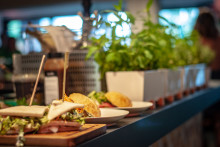A Hobson’s choice is a supposedly free choice where only one item is offered. ‘Take it or leave it’. Welcome to the new catering on campus.
Before you gather your (plastic) pitchforks, let me elaborate. Yes, there is a plethora of food options to choose from. It also seems that almost every cuisine style is present, unless you are into huitlacoche (‘sleeping excrement’) from Mexico. No complaints there.
What I am referring to, however, is the lack of positive karma points I can reap. You see, I am a bad person. I live a Western lifestyle. I let my car fart toxic gas into the atmosphere for about 500 kilometres per week. I tell people not to be materialistic, yet my own place is best described as an odd hybrid between a library and a museum.
So, when I go to a cafeteria on campus, I would like to have the choice of not causing further harm to the environment, or my wallet for that matter.
But, alas, I am presented with a dozen items all neatly wrapped into plastic, I am forced to use plastic cutlery, and most of the food options that are available are as unsustainable as they are expensive.
To be frank, I find it quite tragic that an alumnus from the TU Delft has to clean up the oceans, while here in Twente we are still living in the Plastic Age.
Do you know what each student café needs? A fresh, warm loaf of bread that you can get individual slices from. Then you just add peanut butter, like a proper Dutchman. And if you are a true daredevil, you cut a banana in slices and put those on top.
To any international students who just got a trauma for life: my deepest apologies. Yes, we eat peanut butter sandwiches with banana here. We did evolve a bit though, as we are no longer wearing wooden shoes. Take comfort in that! But I digress.
Do you know why sliced bread was cut (pun not intended) from the menu? Because ‘there was no demand’. Of course, this is the politically correct reason, and the actual reason might be that there’s not much profit to be made from sliced bread.
It is also easy to claim that something has no demand, when you never gave it the same exposure as your other options to begin with. Hence we find ourselves back with Mr. Hobson.
There is an illusion of choice for the students here. And a catch-22 situation for the university. After all, how do you provide sustainable and affordable food options, if you have already convinced yourself that there is no demand, and you have to make a profit somehow?
So, how do we change this? If you fancy yourself a Keynesian economist, you likely adhere to the principle that ‘demand creates its own supply’, hence we must simply start demanding these options. Just make sure that you leave your plastic pitchfork at home.







